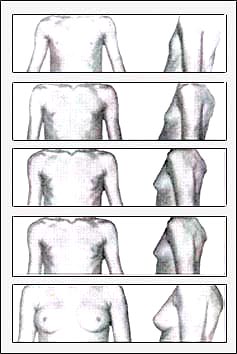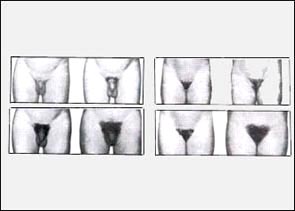사춘기 남녀 아이들의 2차 성장 발육, The secondary sex characteristics developments of the male and female adolescents
- 사춘기가 시작되면 체중과 신장이 급속도로 성장되기 시작한다.
- 그 아이가 성인이 될 때의 추정 체중 치와 추정 신장 치로 성장될 때까지 기간(사진 1-16, 1-17 참조), 또는 2차 성징이 나타나기 시작할 때부터 아기를 생산할 수 있는 자식 생식능력을 가질 때까지 기간을 사춘기라 하고, 그 기간 동안에 속해있는 아이들을 사춘기 아이들이라고 한다.
- 사춘기가 시작되면 시상하부에서 고나도트로핀(성선(샘) 자극 호르몬)과 성장 자극 호르몬이 왕성하게 분비되고 그 호르몬의 영향으로 뇌하수체 전 엽에서 난포자극 호르몬, 황체 자극 호르몬, 성장 호르몬이 분비되어 급속도로 성장 발육되고 2차 성징이 나타나기 시작해서 2차 성징이 완성된다.
- 사춘기가 시작될 때 2차 성징이 나타나는 연령은 남녀 성별에 따라 차이가 있고,
- 성장 발육 속도, 체질, 인종, 사회, 환경 등에 따라 차이난다.
- [부모도 반의사가 되어야 한다-소아가정간호백과]-제3권 신생아들, 영유아들, 학령기 아이들과 사춘기 아이들의 성장발육-9세에서 10까지 성장 발육, 사춘기 아이들 참조.
1. 사춘기 여아들의 2차 성장 발육 단계

사진 1-16. 사춘기 여아들의 유방의 정상 발육(좌 사진).
Used with permission from Vaughan, V.C. McKay. R.J. and Behrman, R.E., Nelson Textbook of Pediatrics of Pediatrics, Philadelphia, W. B. Saunders Co. 1979와 [부모도 반의사가 되어야 한다-소아가정간호백과] p.732-734
- 대부분 여아들의 2차 성징은 10~13세경에 나타나기 시작한다.
- 구체적으로 설명하면,
-
- 사춘기가 시작되면 여아들의 어깨와 엉덩이에 살이 현저히 찌기 시작하고,
- 9~11세경 한쪽 유방이나 양쪽 유방에 젖멍울이 생기며, 그 후 유방이 점차로 더 커지면서 유방, 젖꼭지, 유두륜, 유선, 젖 분비관계 등이 발육되기 시작한다.
- 12~13세경, 성인 여성의 유방의 젖꼭지처럼 젖꼭지가 형성되고,
- 16∼18세경, 성인 여성의 유방 모양과 비슷하게 유방 전체가 거의 발육된다.
- 11∼14세경, 대부분의 사춘기 여아들의 외부생식기와 질이 성인 여성들의 것처럼 발육, 성장되기 시작한다. 이 때 달걀 흰자위와 비슷한 점액이 질에서 분비되기 시작한다.
- 11~12세경, 외부 생식기에 음모가 나기 시작해서
- 11∼15세경, 성인 여성들의 음모의 모양과 비슷하게 곱슬곱슬해진다.
- 12∼14세경, 겨드랑이 털이 나기 시작하고
- 12∼16세경, 여드름이 얼굴에 나기 시작한다.
- 사춘기 여아들의 95%가 14세경 2차 여성 성징이 거의 나타난다.
- 초경이 시작되는 여아들의 나이도 체질·환경·인종, 유전 등에 따라 다르다. 그 중 1 촌이 얼마나 이른 나이에 또는 늦은 나이에 초경을 했느냐에 따라 초경하는 나이가 가장 많이 좌우된다.
- 소스:Contemporary Pediatrics
- 초경이 늦을 때 참조.
2. 사춘기 남아들의 2차 성장 발육

사진 1-17. 사춘기 남아들의 외부 생식기의 정상 발육과 사춘기 여아들의 외부 생식기의 정상 발육(우 사진).
Used with permission from Vaughan, V.C. McKay. R.J. and Behrman, R.E., Nelson Textbook of Pediatrics of Pediatrics, Philadelphia, W. B. Saunders Co. 1979와 [부모도 반의사가 되어야 한다-소아가정간호백과] p.732-734
- 대부분의 남아들의 2차 성징은 10∼14세경에 뚜렷이 나타나기 시작한다. 연구에 의 하면 요즘은 이 보다 1~2년 먼저 2차 성징이 나타난다(2013년).
- 남아들의 사춘기는 여아들의 사춘기보다 약 4개월 정도 늦게 시작해서 그 후 약 4년간 걸쳐 서서히 거의 다 나타 난다.
- 구체적으로 더 설명하면
- 12∼16세경, 한쪽 또는 양쪽 유방에 젖멍울이 생길 수 있고
- 14∼17세경, 유방에 생겼던 젖멍울이 거의 다 없어진다.
- 10∼12세경, 음경과 고환이 커지기 시작해
- 12∼15세경, 성인 남성의 음경과 고환의 크기와 거의 비슷해진다.
- 12∼14세경, 외부 생식기에 음모가 나기 시작하고
- 13∼16세경, 성인 남성의 음모의 모양과 거의 비슷하게 곱슬곱슬해진다.
- 13∼16세경, 겨드랑이 털이 나기 시작하고,
- 15∼17세경, 수염과 체모가 나기 시작한다.
- 14∼18세경, 얼굴에 여드름이 나기 시작하고,
- 14∼16세경, 정자가 생산된다.
The secondary sex characteristics developments of the male and female adolescents
• With the onset of puberty, weight and height begin to grow rapidly.
• The amount of time the child will grow to an estimated weight and height of adulthood (see photos 1-16 and 1-17), or the ability to reproduce offspring from when secondary sexual characteristics begin to appear. The period until they have a child is called puberty, and the children who belong to that period are called puberty children.
• When puberty begins, gonadotropin (gonadotropin) and growth-stimulating hormone are actively secreted from the hypothalamus, and follicle-stimulating hormone, luteinizing hormone, and growth hormone are secreted from the anterior pituitary under the influence of these hormones. It grows and develops rapidly, and secondary sexual characteristics begin to appear, completing secondary sexual characteristics.
• The age at which secondary sexual characteristics appear at the onset of puberty differs depending on the gender,
• Growth It differs depending on the growth rate, constitution, race, society, environment, etc.
www.drleepedsiatrics.com]-Volume 3 Newborns, Infants, School-Ages and Adolescents Growth and Development 9 to 10 Growth and Development, Adolescent Children.
1. Secondary stage of growth and development of adolescent girls

Photo 1-16. Normal breast development in adolescent girls (left photo). Used with permission from Vaughan, V.C. McKay. R.J. and Behrman, R.E., Nelson Textbook of Pediatrics of Pediatrics, Philadelphia, W. B. Saunders Co. 1979 and [Parents should also become anti-doctors – Encyclopedia of Pediatric and Family Nursing] p.732-734
• Secondary sexual characteristics in most girls begin to appear around the age of 10-13. • To be specific,
• o With the onset of puberty, girls begin to gain significant weight on their shoulders and hips,
o Around the age of 9 to 11, breast lumps appear on one or both breasts, and then the breasts, nipples, nipple rings, mammary glands, and the lactation system begin to develop as the breasts grow larger.
o Around the age of 12 to 13, nipples are formed like the nipples of adult female breasts,
o Around the age of 16 to 18, almost the entire breast develops similar to that of an adult female.
o Around the age of 11 to 14, the external genitalia and vagina of most adolescent girls begin to develop and grow like that of adult women. At this time, mucus similar to egg white begins to be secreted from the vagina.
o Around the age of 11-12, pubic hair begins to appear on the external genitalia o Around the age of 11 to 15, it becomes curly similar to the shape of the pubic hair of adult women. o Around the age of 12 to 14, armpit hair begins to grow
o Around the age of 12 to 16, acne begins to appear on the face.
o Nearly 95% of adolescent girls develop secondary female sexual characteristics by the age of 14.
o The age at which menstruation begins also differs according to constitution, environment, race, and heredity. Among them, the age of menarche depends the most on how early or late menarche was.
o Source: Contemporary Pediatrics
o See late menarche.
2. Secondary growth and development of adolescent boys

Photo 1-17. Normal development of external genitalia in adolescent boys and normal external genitalia in adolescent girls (picture right). Used with permission from Vaughan, V.C. McKay. R.J. and Behrman, R.E., Nelson Textbook of Pediatrics of Pediatrics, Philadelphia, W. B. Saunders Co. 1979 and [Parents should also become anti-doctors – Encyclopedia of Pediatric and Family Nursing] p.732-734
• Secondary sexual characteristics in most boys begin to become evident around the age of 10-14. According to research, these days, secondary sexual characteristics appear 1-2 years earlier than this (2013).
• Puberty in boys starts about 4 months later than puberty in girls and appears gradually over the next 4 years.
• If you explain more specifically
o Around the age of 12 to 16, lumps may form on one or both breasts.
o Around the age of 14 to 17, almost all lumps in the breast disappear.
o Around the age of 10 to 12, the penis and testicles begin to grow
o Around the age of 12 to 15, the size of the penis and testicles of an adult male becomes almost identical.
o Around the age of 12 to 14, pubic hair begins to appear on the external genitalia
o Around the age of 13 to 16, the pubic hair of an adult male becomes almost curly.
o Around the age of 13 to 16, armpit hair begins to grow,
o Around the age of 15 to 17, beard and body hair begins to appear.
o Around the age of 14 to 18, acne begins to appear on the face, o Around the age of 14 to 16, sperm are produced.
출처 및 참조 문헌 Sources and references
- NelsonTextbook of Pediatrics 22ND Ed
- The Harriet Lane Handbook 22ND Ed
- Growth and development of the children
- Red Book 32nd Ed 2021-2024
- Neonatal Resuscitation, American Academy Pediatrics
-
- www.drleepediatrics.com 제1권 소아청소년 응급 의료
- www.drleepediatrics.com 제2권 소아청소년 예방
- www.drleepediatrics.com 제3권 소아청소년 성장 발육 육아
- www.drleepediatrics.com 제4권 모유,모유수유, 이유
- www.drleepediatrics.com 제5권 인공영양, 우유, 이유식, 비타민, 미네랄, 단백질, 탄수화물, 지방
- www.drleepediatrics.com 제6권 신생아 성장 발육 육아 질병
- www.drleepediatrics.com제7권 소아청소년 감염병
- www.drleepediatrics.com제8권 소아청소년 호흡기 질환
- www.drleepediatrics.com제9권 소아청소년 소화기 질환
- www.drleepediatrics.com제10권. 소아청소년 신장 비뇨 생식기 질환
- www.drleepediatrics.com제11권. 소아청소년 심장 혈관계 질환
- www.drleepediatrics.com제12권. 소아청소년 신경 정신 질환, 행동 수면 문제
- www.drleepediatrics.com제13권. 소아청소년 혈액, 림프, 종양 질환
- www.drleepediatrics.com제14권. 소아청소년 내분비, 유전, 염색체, 대사, 희귀병
- www.drleepediatrics.com제15권. 소아청소년 알레르기, 자가 면역질환
- www.drleepediatrics.com제16권. 소아청소년 정형외과 질환
- www.drleepediatrics.com제17권. 소아청소년 피부 질환
- www.drleepediatrics.com제18권. 소아청소년 이비인후(귀 코 인두 후두) 질환
- www.drleepediatrics.com제19권. 소아청소년 안과 (눈)질환
- www.drleepediatrics.com 제20권 소아청소년 이 (치아)질환
- www.drleepediatrics.com 제21권 소아청소년 가정 학교 간호
- www.drleepediatrics.com 제22권 아들 딸 이렇게 사랑해 키우세요
- www.drleepediatrics.com 제23권 사춘기 아이들의 성장 발육 질병
- www.drleepediatrics.com 제24권 소아청소년 성교육
- www.drleepediatrics.com 제25권 임신, 분만, 출산, 신생아 돌보기
- Red book 29th-31st edition 2021
- Nelson Text Book of Pediatrics 19th- 21st Edition
- The Johns Hopkins Hospital, The Harriet Lane Handbook, 22nd edition
- 응급환자관리 정담미디어
- Pediatric Nutritional Handbook American Academy of Pediatrics
- 소아가정간호백과–부모도 반의사가 되어야 한다, 이상원 저
- The pregnancy Bible. By Joan stone, MD. Keith Eddleman, MD
- Neonatology Jeffrey J. Pomerance, C. Joan Richardson
- Preparation for Birth. Beverly Savage and Dianna Smith
- 임신에서 신생아 돌보기까지. 이상원
- Breastfeeding. by Ruth Lawrence and Robert Lawrence
- Sources and references on Growth, Development, Cares, and Diseases of Newborn Infants
- Emergency Medical Service for Children, By Ross Lab. May 1989.
- Emergency care, Harvey Grant and Robert Murray
- Emergency Care Transportation of Sick and Injured American Academy of Orthopaedic Surgeons
- Emergency Pediatrics A Guide to Ambulatory Care, Roger M. Barkin, Peter Rosen
- Quick Reference To Pediatric Emergencies, Delmer J. Pascoe, M.D., Moses Grossman, M.D. with 26 contributors
- Neonatal resuscitation Ameican academy of pediatrics
- Pediatric Nutritional Handbook American Academy of Pediatrics
- Pediatric Resuscitation Pediatric Clinics of North America, Stephen M. Schexnayder, M.D.
- Pediatric Critical Care, Pediatric Clinics of North America, James P. Orlowski, M.D.
- Preparation for Birth. Beverly Savage and Dianna Smith
- Infectious disease of children, Saul Krugman, Samuel L Katz, Ann A.
- 제4권 모유, 모유수유, 이유 참조문헌 및 출처
- 제5권 인공영양, 우유, 이유, 비타민, 단백질, 지방 탄수 화물 참조문헌 및 출처
- 제6권 신생아 성장발육 양호 질병 참조문헌 및 출처
- Clinical Atlas of Blood Diseases, Sixth Edition, A. Piney, M.D., and Stanley Wyard M.D., The Blakiston Co
- Hematologic Problems in The Newborn, Third Edition, Volume IV in the series, Major Problems in Clinical Pediatrics, Oski and Naiman, W.B. Saunders.
- Pediatric Hematology, The Pediatric Clinics of North America, June 1996, W.B. Saunders
- Pediatric Hematology, The Pediatric Clinics of North America, May 1980, W.B. Saunders
- 소아과학 대한교과서
- 의학 용어사전 대한 의사 협회
Copyright ⓒ 2014 John Sangwon Lee, MD., FAAP
“부모도 반의사가 되어야 한다”-내용은 여러분들의 의사로부터 얻은 정보와 진료를 대신할 수 없습니다.
“The information contained in this publication should not be used as a substitute for the medical care and advice of your doctor. There may be variations in treatment that your doctor may recommend based on individual facts and circumstances.
“Parental education is the best medicine.